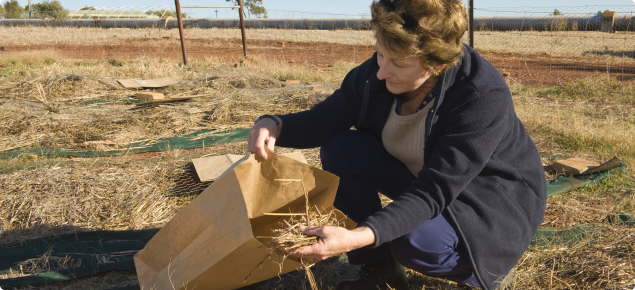Plant disease diagnostics is a fee-based service provided by the DDLS - Plant pathology service. A case handling fee is applied to all submissions to cover administration and overhead charges. The submitter will be invoiced in all cases unless documented otherwise on the submission form at the time of sample submission.
Plant samples must be of adequate quality and quantity (see below) and be accompanied by a completed application form. Forms are available to download from the right menu in this page.
Sampling for general plant disease diagnostics
Please follow these guidelines to ensure you send the most appropriate plant or soil samples for accurate and timely disease diagnosis.
- Take fresh samples, keep them cool and out of direct sunlight.
- Label sample bags clearly with a permanent marker.
- Submit affected and unaffected plants packaged and labelled separately (e.g. inside, outside and boundary of affected areas).
- For plants up to 1m high, submit at least three whole plants, complete with soil, or 20 seedlings.
For plants over 1m high, separate into top and bottom components before submitting. - Submit at least 10 whole plants, or 20 seedlings.
- Send samples as per instructions below.
- Avoid sending samples on a Thursday or Friday otherwise refrigerate until despatched the following week.
- Label the parcel ‘Urgent plant samples - keep cool’.
- Complete the Plant Disease Diagnosis Submission Form.
- Complete a separate form for each species.
Whole plant or root samples
Nursery plants
- Submit whole plants in pots and tubes.
- Submit both healthy and unthrifty plants.
Field/crop plants
- Submit whole plants, unless it is clearly a leaf, stem or fruit disease.
- Dig up plants so that the roots remain intact. Do not pull the plants from the soil.
- Leave the soil on the roots to keep the plants alive during transit. Washed roots will rot while in transit.
- Seal roots and soil in a plastic bag near the base of the plants. Enclose the whole sample inside another plastic bag (Figure 1)
- Enclose seedlings in one bag.
Pasture plants
- Collect as sod samples (20 x 20 cm), to 5-10 cm depth.
- Seal in a plastic bag, without removing the soil from the sample.
Leaf samples
Fungal / bacterial diseases
- Wrap cereal leaves in paper or enclose in a paper envelope. Do not send in plastic.
- Seal pulse or oilseed leaves in a plastic bag.
- Wrap leaves from horticultural crops in paper and enclose in a paper envelope or unsealed plastic bag.
Viral diseases
- Collect new growth (newest fully developed leaves) or whole shoots.
- For potatoes, shoots or tubers can be sent.
- For grapevines, collect dormant canes. Canes to be 10-20cm in length, 3 canes per vine. A maximum of 10 vines can be grouped together for testing as one sample.
- Seal samples immediately in a plastic bag to prevent wilting.
- Package to avoid leaves getting squashed.
- The number of leaves/shoots sampled should be in multiples of the testing groups sought. (e.g. for testing in groups of 10, you could sample 100 leaves).
Turnaround time for virus testing
- Leaves – approximately 7 working days
- Grapevine canes – approximately 10 working days
- Potato tuber – approximately 6 weeks (tubers are sprouted prior to testing).
Soil samples for detection of Nematodes, or Pleiochaeta spore counts
For Broadacre crops/paddocks
Nematodes (moist soils) and Pleiochaeta spore counts
- Use a soil corer (e.g. pogo stick) to sample 0-10 cm (0-4").
- Remove surface debris in the area to be sampled.
- Sample soil for nematodes at 6-12 locations towards the margin of poor growth areas.
- Or collect 40 soil samples from wide paddock areas.
- Place in a bucket and mix thoroughly.
- Remove a 500g sample and seal in a plastic bag. Label the bag.
For horticultural crops/paddocks
Pre-planting (moist soils)
- Use a soil corer (e.g. pogo stick) to sample 0-20 cm (0-8").
- Remove surface debris in the area to be sampled.
- Sample soil for nematodes on a grid pattern, taking 20 samples per hectare, 500 g per sample.
- If a result for each sample is required seal samples separately in plastic bags. Label each bag. Otherwise mix all soil samples thoroughly but gently and take a 500g sample from this mix, seal sample in a plastic bag and label.
- Soil samples from tropical and subtropical areas should be stored at 10°C, but soil samples from other areas can be refrigerated.
- Do not allow temperature of any samples to rise above 25°C during transit.
Existing plants
- Use a soil corer or narrow shovel to sample to a depth of 20 cm.
- Remove surface debris from around the base of the plant.
- Collect 500 g of soil from the root zone of the plant.
- Take soil from three unthrifty plants and from one healthy plant.
- Seal samples separately in plastic bags. Label each bag.
- Soil samples for detection of Phytophthora (Dieback).
Pre-planting
- Follow sampling procedure outlined above for nematodes (pre-planting). However, samples can be refrigerated.
Existing plants
- Follow sampling procedure outlined above for nematodes (existing plants).
- Sample from three plants showing dieback symptoms and from one healthy plant.

